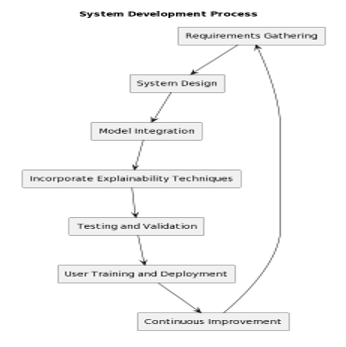A Medical Diagnosis System Based on Explainable Artificial Intelligence: Autism Spectrum Disorder Diagnosis
Keywords:
Explainable AI, Medical Diagnosis, Autism Spectrum Disorder, Machine Learning, Interpretable InsightsAbstract
This paper introduces a new diagnostic system for Autism Spectrum Disorder (ASD) using explainable artificial intelligence (AI). The goal is to develop a reliable and interpretable tool that helps healthcare professionals accurately identify individuals with ASD. The study follows a systematic methodology involving comprehensive data collection, feature engineering, and advanced machine learning algorithms, such as decision trees and support vector machines. By analyzing various patient data, including behavioral observations and medical history, the system identifies important features and patterns associated with ASD. The diagnostic system achieves promising results, with the decision tree model achieving an accuracy of 85% and the support vector machine model achieving 86%. These outcomes demonstrate the potential of the system to accurately identify ASD cases. The clinical relevance and practical implications of the diagnostic system are discussed, emphasizing its ability to enhance the accuracy and efficiency of ASD diagnoses. The paper also identifies limitations and proposes future enhancements, including expanding datasets to cover a wider age range and demographic factors, incorporating additional relevant features such as genetic markers and neuroimaging data, exploring alternative machine learning algorithms, and further advancing explainable AI techniques. Real-world validation and feedback from clinicians and caregivers are crucial for refining the system. Ultimately, this research aims to contribute to timely interventions and improved outcomes for individuals with ASD, providing valuable insights for clinicians, caregivers, and researchers in addressing the challenges of ASD diagnosis.
Downloads
References
Das, A., & Rad, P. (2020). Opportunities and challenges in explainable artificial intelligence (xai): A survey. arXiv preprint arXiv:2006.11371.
Matson, J. L., Nebel-Schwalm, M., & Matson, M. L. (2007). A review of methodological issues in the differential diagnosis of autism spectrum disorders in children. Research in Autism Spectrum Disorders, 1(1), 38-54.
Swathy, M., & Saruladha, K. (2022). A comparative study of classification and prediction of Cardio-Vascular Diseases (CVD) using Machine Learning and Deep Learning techniques. ICT Express, 8(1), 109-116.
Workowski, K. A., & Berman, S. M. (2011). Centers for Disease Control and Prevention sexually transmitted disease treatment guidelines. Clinical infectious diseases, 53(suppl_3), S59-S63.
Kirwan, J. R., De Saintonge, D. M. C., & Joyce, C. R. B. (1990). Clinical judgment analysis. QJM: An International Journal of Medicine, 76(3), 935-949.
Shefner, J. M., Al-Chalabi, A., Baker, M. R., Cui, L. Y., de Carvalho, M., Eisen, A., ... & Kiernan, M. C. (2020). A proposal for new diagnostic criteria for ALS. Clinical Neurophysiology, 131(8).
Kratochwill, T. R., & Bergan, J. R. (1990). Behavioral consultation in applied settings: An individual guide. Springer Science & Business Media.
Coccaro, E. F., Harvey, P. D., Kupsaw-Lawrence, E., Herbert, J. L., & Bernstein, D. P. (1991). Development of neuropharmacologically based behavioral assessments of impulsive aggressive behavior. The Journal of Neuropsychiatry and Clinical Neurosciences.
Tabtah, F. (2017). Autism Spectrum Disorder Screening: Machine Learning Adaptation and DSM-5 Fulfillment. Proceedings of the 1st International Conference on Medical and Health Informatics 2017, pp.1-6. Taichung City, Taiwan, ACM.
Hus, V., & Lord, C. (2014). The autism diagnostic observation schedule, module 4: revised algorithm and standardized severity scores. Journal of autism and developmental disorders, 44, 1996-2012.
Zander, E., Willfors, C., Berggren, S., Coco, C., Holm, A., Jifält, I., ... & Bölte, S. (2017). The interrater reliability of the autism diagnostic interview-revised (ADI-R) in clinical settings. Psychopathology, 50(3), 219-227.
Rodriguez-Galiano, V., Sanchez-Castillo, M., Chica-Olmo, M., & Chica-Rivas, M. J. O. G. R. (2015). Machine learning predictive models for mineral prospectivity: An evaluation of neural networks, random forest, regression trees and support vector machines. Ore Geology Reviews, 71, 804-818.
Dinesh Chandra , Shaziya Islam , Deepak pandey (2019). Prediction of Dengue with the Use of AI and Data Mining: An Expert System. International Journal of Computer Engineering in Research Trends.6(7),340-346.
Anand Pagnis, Vedansh Tembhre , Pranjal Vyas (2021). Technological Singularity – An Overview of What the Future Holds. International Journal of Computer Engineering in Research Trends.8(10),171-174.
Dinesh Chandra, Shaziya Islam, Deepak Pandey (2019). Prediction of dengue with the use of AI and Data mining: An Expert system. International Journal of Computer Engineering in Research Trends.6(7),340-346.
Solomon Osarumwense Alile (2020). An Ischemic Heart Disease Prediction Model Based on Observed Symptoms Using Machine Learning. International Journal of Computer Engineering in Research Trends.7(9),9-22
M. M. Venkata Chalapathi, M. Rudra Kumar, Neeraj Sharma, S. Shitharth, "Ensemble Learning by High-Dimensional Acoustic Features for Emotion Recognition from Speech Audio Signal", Security and Communication Networks, vol. 2022, Article ID 8777026, 10 pages, 2022.
Ramana, Kadiyala, et al. "Leaf disease classification in smart agriculture using deep neural network architecture and IoT." Journal of Circuits, Systems and Computers 31.15 (2022): 2240004. https://doi.org/10.1142/S0218126622400047

Downloads
Published
How to Cite
Issue
Section
License
Copyright (c) 2023 J. Adilakshmi, G. Vinoda Reddy, Krishan Dev Nidumolu, Renzon Daniel Cosme Pecho , M. Jahir Pasha

This work is licensed under a Creative Commons Attribution-ShareAlike 4.0 International License.
All papers should be submitted electronically. All submitted manuscripts must be original work that is not under submission at another journal or under consideration for publication in another form, such as a monograph or chapter of a book. Authors of submitted papers are obligated not to submit their paper for publication elsewhere until an editorial decision is rendered on their submission. Further, authors of accepted papers are prohibited from publishing the results in other publications that appear before the paper is published in the Journal unless they receive approval for doing so from the Editor-In-Chief.
IJISAE open access articles are licensed under a Creative Commons Attribution-ShareAlike 4.0 International License. This license lets the audience to give appropriate credit, provide a link to the license, and indicate if changes were made and if they remix, transform, or build upon the material, they must distribute contributions under the same license as the original.





